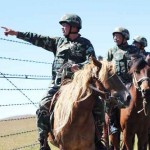Guerrilla Warfare in The Riverine Delta: Guerrilla warfare came into vogue during the Napoleonic wars. This type of warfare should not to be confused with the guerrilla tactics employed by regular armies in the world wars such as General Wingate’s Chindits who operated behind enemy lines in Japanese-occupied Burma. In the present context, guerrillas could be described as ‘free citizens who took up arms to liberate their country’.
Similar organizations have been in vogue in Africa, Latin America and South-East Asia with varying degrees of success a~ witnessed in Mozambique, Angola, Kenya, Uganda, Chile, Cambodia and Vietnam. The Brussels Conference of 1874 accorded such guerrilla outfits the status of regular soldiers which was again incorporated in the Hague Regulations of 1899 provided they had a commander, carried weapons overtly and put on uniforms.
Click to buy: War in the Indian Ocean
In the riverine environment of East Pakistan, the waterborne guerrilla will be referred to as ‘frogmen’ to differentiate them from the land-based Mukti Bahini force with both operating under the legendary leader Colonel M.A.G. Osmani. A bachelor who was considered as the father of the East Bengal Regiment, he likened himself to General Charles de Gaulle of France during the period of German occupation.
“¦whose only aim was to take revenge on the West Pakistan forces for killing and raping their kith and kin and literally driving out millions of their citizens from out of their homes and across the borders to “˜HINDU INDIA.
The frogmen were more akin to the Vietminh guerrillas who emphasized the need for protecting the local population by attacking, exhausting and then forcing the enemy on to the defensive. And like Giap, Nasution and Guevaro, the East Bengal guerrillas were a combination of both rural and urban proletariats whose only aim was to take revenge on the West Pakistan forces for killing and raping their kith and kin and literally driving out millions of their citizens from out of their homes and across the borders to ‘HINDU INDIA’. Hence, it will be of interest to analyse the winning tactics of the riverine guerrillas for attaining their objectives during the 1971 conflict in East Pakistan. Their saga of courage. determination and sacrifice still remains largely untold and unsung even after a quarter century.
East Bengal had historically provided the necessary ingredients to generate national uprising. As far back as 1830, Titu Mian, a Fairzini leader, led a revolt of Muslim peasantry in Bengal. Later, during the partition of Bengal, British goods were boycotted and ‘Vande Mataram’ heralded a patriotic resistance which was spearheaded by Surendra Nath Banerjee, the Editor of the English daily Bengali. He was arrested in Barisal which further fed the fires for the uprising against the partition of Bengal.
Similarly, with the arrest of Sheikh Mujibur Rehman on 25 March 1971 at Dacca the liberation of Bangladesh was set in motion with the formation of the Mukti Fauj which later became the Mukti Bahini (freedom fighters). These freedom fighters were broadly divided in four categories.
The Mukti Bahini or Mukti Fauj as earlier labelled were at the beginning badly mauled but soon changed their tactics “˜to hit and run raids as they had little capacity to capture or hold territory.
- The Niamit Bahini comprising initially of the East Bengal Regiment, East Pakistan Rifles and civil police. They were expanded by thousands of Bengali youths joining this freedom movement. They wore uniforms and were generally led by the former Bengali Army and police officers. Initially, they sought to take on the Pakistan Army which has been expanded to four divisions and equipped with heavy weapons, artillery and tanks. These regular Pakistan forces in turn were assisted by Razakars. They were mainly local Biharis termed as Mujahids (armed with shotguns) or Ansaris (armed with lathis). The Mukti Bahini or Mukti Fauj as earlier labelled were at the beginning badly mauled but soon changed their tactics ‘to hit and run raids’ as they had little capacity to capture or hold territory. The prime targets of the freedom fighters were refineries, military dumps, vital communication centres and border posts.
- Gona Bahini irregular forces targeted bridges, railway tracks and power houses.
- Bicchus (scorpions) was a girls’ brigade which collected intelligence, acted as couriers and damaged installations.
- Mukti Bahini frogmen, who mainly operated in the riverine areas with the aim of neutralizing the main seaports of Chittagong, Chalna, Mongla and Khulna to prevent supplies being brought into the Eastern segment of Pakistan for bolstering the Army of occupation. They sought to stop the traditional exports of jute, tea, coir, etc. which earned badly needed foreign exchange for Pakistan’s military dictators. The third aim was to disrupt the inland waterway systems as also the river ports of Naryangunj, Daudkhandi, Chandpur and Barisal which were the main arteries of communication in estuarine Bengal. And lastly to prevent the West Pakistani forces from escaping by sea.
They were completely devoted to their objectives and on achieving independence were content to slip back to their everyday way of life without fuss or fanfare.
The Mukti Bahini frogmen were tough. both mentally and physically and had all the characteristics which the Vietnamese schoolmaster; General Giap had itemized as the ingredients for successful guerrilla campaign, viz. courage, endurance and aggressiveness. Above all, their burning desire for revenge overcame all obstacles as they were glad to lay down their lives for their beloved ‘Sonar Bangia’. Moreover, these frogmen had little political or post-insurrection ambitions unlike guerrilla forces of other nations. They were completely devoted to their objectives and on achieving independence were content to slip back to their everyday way of life without fuss or fanfare. These remarkable estuarine operations were but a brief interlude in their young lives.




